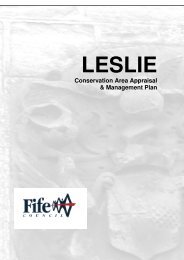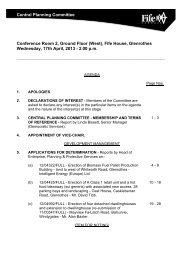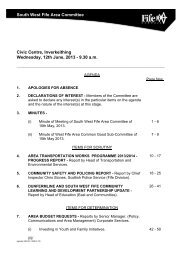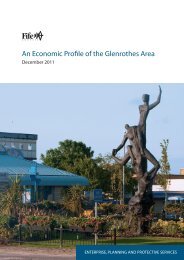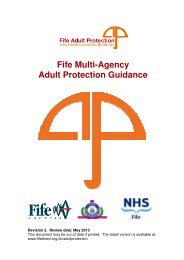Early & Flexible Retirement
Early & Flexible Retirement
Early & Flexible Retirement
Create successful ePaper yourself
Turn your PDF publications into a flip-book with our unique Google optimized e-Paper software.
<strong>Early</strong> & <strong>Flexible</strong><strong>Retirement</strong>GuidelinesContentsPurpose 2Eligible Employees 2Old Rule of 85 2Application Process 3<strong>Flexible</strong> <strong>Retirement</strong> 4Role of Human Resources 5Compensatory Benefits 5Scale for Compensatory Added Years 6Discretionary Compensation Payments –Tables 8Statutory Redundancy Payments 12Definitions of Service and Pay 14<strong>Retirement</strong> on ExceptionalCompassionate Grounds 15Re-employment 15Employees Nearing Normal ContractEnd Date 15Appeals 16<strong>Early</strong> <strong>Retirement</strong> Approval andDelegated Authority to Agree 17Further Information 19Managing People<strong>Early</strong> <strong>Retirement</strong>Fife Council September 2011 Page 1 of 19 ER11
PurposeThis document provides operational guidelines for use with the policy ER01 <strong>Early</strong><strong>Retirement</strong> Policy.Eligible EmployeesEmployee GroupsThe policy applies to Fife Council employees who are eligible to join the LocalGovernment Pension Scheme (LGPS). This means “single status” employees, “craft”employees, chief officers and police civilians. An employee does not have to be amember of the scheme to be included. Instead the employee only has to be eligibleto join.Some parts only apply to LGPS members. The guidelines below explain this.<strong>Early</strong> <strong>Retirement</strong>Employees who are age 50 or above and have at least 2 years membership of theLocal Government Pension Scheme at their date of leaving can receive their pensionbenefits, subject to the criteria outlined below.Those aged 60 or over can retire without the approval of the Council.Those aged 55 to 59 can retire with the approval of the Council. In cases of earlyretirement because of redundancy or in the interests of business efficiency theminimum age for employees who were members of the scheme on 5 April 2006 is50. For other scheme members the minimum age is 55.Employees can be offered early retirement on exceptional compassionate groundsafter age 55. Other than this, decisions about early retirement on exceptionalcompassionate grounds are not age related.<strong>Flexible</strong> <strong>Retirement</strong>Those aged 55 or over may flexibly retire with the approval of the Council.Voluntary RedundancyEmployees with at least two years continuous service may be considered forvoluntary redundancy with a discretionary compensation payment.Redundancy CompensationThe compensation listed in these guidelines is also applicable to employees maderedundant who have not volunteered. The age and service criteria above also applyto employees in this group.Old Rule of 85Before 2006 a member whose age and membership in years combined was 85 ormore was said to meet the “Rule of 85”. Once this happened there would be noManaging People<strong>Early</strong> <strong>Retirement</strong>Fife Council September 2011 Page 2 of 19 ER11
eduction in pension for early payment. In other words the only thing that wouldaffect the amount of pension for someone who met the Rule of 85 would be thenumber of years’ membership on retirement and his or her pay. The Rule of 85 nolonger applies to new members.If an employee who meets the “Rule of 85” wishes to retire before age 60 theconsent of the employing service is still required. The additional costs of "Rule of 85"benefits will be charged to the employing service.There are transitional arrangements for people who were members of the schemeon 1st December 2006.Application Process<strong>Early</strong> <strong>Retirement</strong> (Not Redundancy or Business Efficiency)To request, or enquire about, early retirement, an employee should complete andsubmit an ER50 <strong>Early</strong> <strong>Retirement</strong> Request Form.There will be a cost to the service in agreeing to grant early retirement. Inconjunction with their service accounting team, the Service will need to considerhow this cost can be met and any associated benefits before making a final decision.If the request is approved in principle, Pensions section will prepare an estimate ofthe benefits payable and forward this to the employee.If the request is being turned down the budget holder should write to the employeeexplaining why the request cannot be taken forward.<strong>Early</strong> <strong>Retirement</strong> on Exceptional Compassionate GroundsTo request, or enquire about, early retirement on exceptional compassionategrounds, an employee should complete and submit an ER59 Application to Retire onCompassionate Grounds Form .Volunteers for Redundancy and <strong>Retirement</strong>s in the Interests of Business EfficiencyExpressions of interest in voluntary redundancy as a result of managing change andworkforce reduction programmes are managed through the HR Workforce ChangeTeam. Contact the HR Workforce Change Team / HR Business Partner for furtherinformation.Consent from the CouncilEmployees have the right to request an estimate of their benefits at any time.However, since an employee cannot retire before age 60 without the Council'sconsent, it is recommended that the application process for early retirement isfollowed. For reasons of administrative efficiency such requests should be limited tono more than one per year. Employees wishing a pension quotation at or after 60can apply direct to the pension team or refer to their most recent annual benefitsstatement.Employees need the employer’s consent to retire flexibly regardless of age.Managing People<strong>Early</strong> <strong>Retirement</strong>Fife Council September 2011 Page 3 of 19 ER11
4B<strong>Flexible</strong> <strong>Retirement</strong>Applications for flexible retirement should be made by writing to the budget holderfor the post, with a proposal. (A guide for managers about handling requests isavailable: HUER63 <strong>Flexible</strong> <strong>Retirement</strong> Managers GuideUH).The proposal should give detailsof how the employee would like to continue to work, while reducing salary to notmore than 80% of current salary. Examples of how this salary reduction could beachieved include a reduction in hours or by applying for a lower graded job.The proposal should give a business case for the flexible retirement request. Thisshould include an indication of how the employee believes the Service will continueto meet service delivery obligations if the request is agreed. A desired date for theflexible retirement should be included. This must take account of issues such as thetime required to consult with other employees affected, or to recruit a replacement.A meeting should be held to discuss the proposal. If required the proposal should bemodified to take account of the outcome of the meeting.The budget holder and Head of Service will then decide, in consultation with HRDirect / HR Workforce Change Team and the Service accountant, whether theapplication will be approved or not, having considered the criteria for grantingflexible retirement outlined in the relevant policy and considering the costs to theCouncil.When considering flexible retirement proposals, management should always assesshow agreeing a request can result in benefits to the Service. For example, if anemployee is asking to reduce hours there should be an initial presumption that thehours will not be replaced, thus resulting in a budget saving.Where the budget holder supports an application, a calculation of estimated benefitspayable will be prepared and forwarded to the employee. At the same time thebudget holder should prepare and discuss with the Service accountant a reportdetailing the costs associated with the request and how these will be justified by thebenefits to the Service.If the request is being turned down the budget holder should write to the employeeexplaining why the proposal cannot be taken forward.The effective date of flexible retirement will be the date when the changes to theemployee’s contract take effect. If the employee is changing roles this will usually bethe start date of the new job.The manager responsible for the new, or modified, job should write to theemployee with details of the aspects that have changed. Typically this letter willinclude details of the kind below. (The final point must always be included.)• New or changed place, hours, or days of work• New or changed job title or role• New or changed duties or responsibilities• That in accepting flexible retirement the employee may not at a later date applyfor a job that would result in him or her earning more that 80% of the preflexibleretirement salary (as adjusted for nationally agreed pay increases)Managing People<strong>Early</strong> <strong>Retirement</strong>Fife Council September 2011 Page 4 of 19 ER11
See HUER67 <strong>Flexible</strong> <strong>Retirement</strong> Model LettersUH. People considering flexible retirementshould be given a copy of HUER61 <strong>Flexible</strong> <strong>Retirement</strong> Employee Fact Sheet.U5BRole of Human ResourcesHR Direct / HR Workforce Change Team are available to provide advice at any timein relation to early retirement and queries about specific early retirement casesshould be addressed to them. In conjunction with the Pensions Section, they willprovide assistance with the procedures where required and will monitor thatretirements are being approved in accordance with the policy.6BCompensatory Benefits62BURedundancy – Voluntary or Compulsory• Access to pension without actuarial reduction (if eligible)• For any redundancy payments the value of a week’s pay will be based on actualpay rather than statutory maximum• Statutory redundancy payment (Table 3)• A choice of compensatory added years or discretionary compensation payment(Table 1)Discretionary compensation payments (DCP) will be calculated using the formula forstatutory redundancy payments multiplied by 2.5 giving a maximum of 75 weeks pay.The DCP includes the statutory redundancy payment.72BUInterests of Business Efficiency• Access to pension without actuarial reduction (if eligible)Exceptionally in cases of interests of business efficiency, the Council may, at itsdiscretion, award additional compensatory benefits.• Discretionary added years, or discretionary compensation payment, or a choiceof discretionary added years or discretionary compensation payment subject toaffordability and not exceeding the limits in the scale for added years and scalefor DCP (Table 2).The offer of additional compensation will be assessed by considering the costs andsaving associated with the retirement.An estimate will be obtained from HR Workforce Change Team and based on thisone of the following outcomes should be decided upon:1. The costs of the retirement exceed the savings and it cannot be offered.2. The costs of the retirement mean that it can be offered, but only with accessto pension without actuarial reduction (if eligible), and without additionalcompensatory benefits.3. The costs of the retirement mean that additional compensation can beoffered. Where maximum added years, and, or, maximum DCP as identifiedin the tables below can be afforded this should be offered. If one of theManaging People<strong>Early</strong> <strong>Retirement</strong>Fife Council September 2011 Page 5 of 19 ER11
forms of compensation is affordable but the other is not then the Serviceshould offer only the affordable compensation. If both are affordable, bothshould be offered.If a situation occurs where the retirement does not appear affordable, or theemployee is not interested in the compensation offered, and the Service decidesthat it is still in the interests of business efficiency to investigate the retirementoption further, contact the HR Business Partner for additional advice.Part Time EmployeesAdditional membership for part-time employees will be reduced pro rata to theirhours of work.Employees Who Have Flexibly RetiredEmployees who have flexibly retired and who have rejoined the pension scheme willhave eligibility for added years based on service and membership after flexibleretirement only. Eligibility for Discretionary Compensation Payment will be based oncontinuous service, including service before flexible retirement.Summary of Eligibility Criteria for Additional Membership or DiscretionaryCompensation Payment (DCP)This table is for employees eligible to compensation because of early retirement inpotential redundancy situations or in the interests of business efficiency.Employee StatusCompensationScheme member or non-schemeDCPmember (2 years + service)Scheme member, age 50 1 – 64 inclusive(5 years + LGPS membership)Scale for Compensatory Added YearsAdded years or DCPFor redundancy, added years will be offered based on all previous service with FifeCouncil or an “associated employer” in the Redundancy Payments (Continuity ofEmployment in Local Government, etc.) (Modification) Order 1999 (as amended).1 The minimum age to be allowed to retire on these grounds is 55 for employees who joined thescheme after 5 April 2006.Managing People<strong>Early</strong> <strong>Retirement</strong>Fife Council September 2011 Page 6 of 19 ER11
For retirements in the interests of business efficiency, this table gives the maximumadded years that may normally be granted based on continuous service.Length of ServiceAdded Years5 years – less than 10 years One10 years – less than 15 years Two15 years – less than 20 years Three20 years – less than 25 years Four25 years – less than 30 years Five30 years or longer Six and two thirdsAward added year’s membership is limited by scheme rules which are:• Award of added years requires a minimum of 5 years LGPS membership• Added years membership greater than current membership may not be offered• Added years membership must not result in membership exceeding 40 years• Added years membership must not result in membership exceeding what itwould been at age 6513BUAdditional Membership Types and CostsThe Council can provide additional pension scheme membership in one of two ways:added years or, in exceptional circumstances, augmentation. Additional membershipby augmentation will be at the same levels and restrictions as added years.• Added years are calculated as 1/80 th pension per year and 3/80 th lump sumper year.• Augmentation is calculated as 1/60 th pension per year with no lump sum.However the employee has an option to give up part of their pension for alump sum.Augmentation or added years both have the same effect for the employee, the keydifference being how this is funded by the Service. Essentially augmentation has to bepaid for in full to the pension scheme at the time of the redundancy. However,added years can be funded for the duration of the pension.23BUAdditional Membership by AugmentationDue to the way in which it is funded, providing additional membership byaugmentation is only likely to be considered in very exceptional circumstances. Forthis reason, it must be discussed in advance with Human Resources and PensionsSection before any further action is taken.Additional membership provided by augmentation instead of added years requiresadditional approval. The table at the end of this document lists the approval needed.Managing People<strong>Early</strong> <strong>Retirement</strong>Fife Council September 2011 Page 7 of 19 ER11
Discretionary Compensation Payments – TablesThe following tables give the number of week’s compensation pay depending on ageand length of continuous service.Table 1a - Voluntary Redundancy – Discretionary Compensation PaymentsCompleted Years of Service2 3 4 5 6 7 8 9 1018-22 2.5 3.75 5 6.25 7.5 8.7523 3.75 5 6.25 7.5 8.75 10 11.2524 5 6.25 7.5 8.75 10 11.25 12.5 13.7525 5 7.5 8.75 10 11.25 12.5 13.75 15 16.2526 5 7.5 10 11.25 12.5 13.75 15 16.25 17.527 5 7.5 10 12.5 13.75 15 16.25 17.5 18.7528 5 7.5 10 12.5 15 16.25 17.5 18.75 2029 5 7.5 10 12.5 15 17.5 18.75 20 21.2530 5 7.5 10 12.5 15 17.5 20 21.25 22.531 5 7.5 10 12.5 15 17.5 20 22.5 23.7532 5 7.5 10 12.5 15 17.5 20 22.5 2533-40 5 7.5 10 12.5 15 17.5 20 22.5 2541 5 7.5 10 12.5 15 17.5 20 22.5 2542 6.25 8.75 11.25 13.75 16.25 18.75 21.25 23.75 26.2543 7.5 10 12.5 15 17.5 20 22.5 25 27.544 7.5 11.25 13.75 16.25 18.75 21.25 23.75 26.25 28.7545 7.5 11.25 15 17.5 20 22.5 25 27.5 3046 7.5 11.25 15 18.75 21.25 23.75 26.25 28.75 31.2547 7.5 11.25 15 18.75 22.5 25 27.5 30 32.548 7.5 11.25 15 18.75 22.5 26.25 28.75 31.25 33.7549 7.5 11.25 15 18.75 22.5 26.25 30 32.5 3550 7.5 11.25 15 18.75 22.5 26.25 30 33.75 36.2551 7.5 11.25 15 18.75 22.5 26.25 30 33.75 37.552+ 7.5 11.25 15 18.75 22.5 26.25 30 33.75 37.52 3 4 5 6 7 8 9 10The discretionary compensation payments in this table include statutory redundancypay.AgeManaging People<strong>Early</strong> <strong>Retirement</strong>Fife Council September 2011 Page 8 of 19 ER11
Table 1b - Voluntary Redundancy – Discretionary Compensation Payments(Continued)AgeCompleted Years of Service11 12 13 14 15 16 17 18 19 2026 18.7527 20 21.2528 21.25 22.5 23.7529 22.5 23.75 25 26.2530 23.75 25 26.25 27.5 28.7531 25 26.25 27.5 28.75 30 31.2532 26.25 27.5 28.75 30 31.25 32.5 33.7533 27.5 28.75 30 31.25 32.5 33.75 35 36.2534 27.5 30 31.25 32.5 33.75 35 36.25 37.5 38.7535 27.5 30 32.5 33.75 35 36.25 37.5 38.75 40 41.2536 27.5 30 32.5 35 36.25 37.5 38.75 40 41.25 42.537 27.5 30 32.5 35 37.5 38.75 40 41.25 42.5 43.7538 27.5 30 32.5 35 37.5 40 41.25 42.5 43.75 4539 27.5 30 32.5 35 37.5 40 42.5 43.75 45 46.2540 27.5 30 32.5 35 37.5 40 42.5 45 46.25 47.541 27.5 30 32.5 35 37.5 40 42.5 45 47.5 48.7542 28.75 31.25 33.75 36.25 38.75 41.25 43.75 46.25 48.75 51.2543 30 32.5 35 37.5 40 42.5 45 47.5 50 52.544 31.25 33.75 36.25 38.75 41.25 43.75 46.25 48.75 51.25 53.7545 32.5 35 37.5 40 42.5 45 47.5 50 52.5 5546 33.75 36.25 38.75 41.25 43.75 46.25 48.75 51.25 53.75 56.2547 35 37.5 40 42.5 45 47.5 50 52.5 55 57.548 36.25 38.75 41.25 43.75 46.25 48.75 51.25 53.75 56.25 58.7549 37.5 40 42.5 45 47.5 50 52.5 55 57.5 6050 38.75 41.25 43.75 46.25 48.75 51.25 53.75 56.25 58.75 61.2551 40 42.5 45 47.5 50 52.5 55 57.5 60 62.552 41.25 43.75 46.25 48.75 51.25 53.75 56.25 58.75 61.25 63.7553 41.25 45 47.5 50 52.5 55 57.5 60 62.5 6554 41.25 45 48.75 51.25 53.75 56.25 58.75 61.25 63.75 66.2555 41.25 45 48.75 52.5 55 57.5 60 62.5 65 67.556 41.25 45 48.75 52.5 56.25 58.75 61.25 63.75 66.25 68.7557 41.25 45 48.75 52.5 56.25 60 62.5 65 67.5 7058 41.25 45 48.75 52.5 56.25 60 63.75 66.25 68.75 71.2559 41.25 45 48.75 52.5 56.25 60 63.75 67.5 70 72.560 41.25 45 48.75 52.5 56.25 60 63.75 67.5 71.25 73.7561+ 41.25 45 48.75 52.5 56.25 60 63.75 67.5 71.25 7511 12 13 14 15 16 17 18 19 20The discretionary compensation payments in this table include statutory redundancypay.Managing People<strong>Early</strong> <strong>Retirement</strong>Fife Council September 2011 Page 9 of 19 ER11
Table 2a - Interests of Business Efficiency –Discretionary Compensation PaymentsAgeCompleted Years of Service2 3 4 5 6 7 8 9 1018-22 2.2 3.3 4.4 5.5 6.6 7.723 3.3 4.4 5.5 6.6 7.7 8.8 9.924 4.4 5.5 6.6 7.7 8.8 9.9 11 12.125 4.4 6.6 7.7 8.8 9.9 11 12.1 13.2 14.326 4.4 6.6 8.8 9.9 11 12.1 13.2 14.3 15.427 4.4 6.6 8.8 11 12.1 13.2 14.3 15.4 16.528 4.4 6.6 8.8 11 13.2 14.3 15.4 16.5 17.629 4.4 6.6 8.8 11 13.2 15.4 16.5 17.6 18.730 4.4 6.6 8.8 11 13.2 15.4 17.6 18.7 19.831 4.4 6.6 8.8 11 13.2 15.4 17.6 19.8 20.932 4.4 6.6 8.8 11 13.2 15.4 17.6 19.8 2233-40 4.4 6.6 8.8 11 13.2 15.4 17.6 19.8 2241 4.4 6.6 8.8 11 13.2 15.4 17.6 19.8 2242 5.5 7.7 9.9 12.1 14.3 16.5 18.7 20.9 23.143 6.6 8.8 11 13.2 15.4 17.6 19.8 22 24.244 6.6 9.9 12.1 14.3 16.5 18.7 20.9 23.1 25.345 6.6 9.9 13.2 15.4 17.6 19.8 22 24.2 26.446 6.6 9.9 13.2 16.5 18.7 20.9 23.1 25.3 27.547 6.6 9.9 13.2 16.5 19.8 22 24.2 26.4 28.648 6.6 9.9 13.2 16.5 19.8 23.1 25.3 27.5 29.749 6.6 9.9 13.2 16.5 19.8 23.1 26.4 28.6 30.850 6.6 9.9 13.2 16.5 19.8 23.1 26.4 29.7 31.951 6.6 9.9 13.2 16.5 19.8 23.1 26.4 29.7 3352+ 6.6 9.9 13.2 16.5 19.8 23.1 26.4 29.7 332 3 4 5 6 7 8 9 10Managing People<strong>Early</strong> <strong>Retirement</strong>Fife Council September 2011 Page 10 of 19 ER11
Table 2b - Interests of Business Efficiency –Discretionary Compensation Payments(Continued)AgeCompleted Years of Service11 12 13 14 15 16 17 18 19 2026 16.527 17.6 18.728 18.7 19.8 20.929 19.8 20.9 22 23.130 20.9 22 23.1 24.2 25.331 22 23.1 24.2 25.3 26.4 27.532 23.1 24.2 25.3 26.4 27.5 28.6 29.733 24.2 25.3 26.4 27.5 28.6 29.7 30.8 31.934 24.2 26.4 27.5 28.6 29.7 30.8 31.9 33 34.135 24.2 26.4 28.6 29.7 30.8 31.9 33 34.1 35.2 36.336 24.2 26.4 28.6 30.8 31.9 33 34.1 35.2 36.3 37.437 24.2 26.4 28.6 30.8 33 34.1 35.2 36.3 37.4 38.538 24.2 26.4 28.6 30.8 33 35.2 36.3 37.4 38.5 39.639 24.2 26.4 28.6 30.8 33 35.2 37.4 38.5 39.6 40.740 24.2 26.4 28.6 30.8 33 35.2 37.4 39.6 40.7 41.841 24.2 26.4 28.6 30.8 33 35.2 37.4 39.6 41.8 42.942 25.3 27.5 29.7 31.9 34.1 36.3 38.5 40.7 42.9 45.143 26.4 28.6 30.8 33 35.2 37.4 39.6 41.8 44 46.244 27.5 29.7 31.9 34.1 36.3 38.5 40.7 42.9 45.1 47.345 28.6 30.8 33 35.2 37.4 39.6 41.8 44 46.2 48.446 29.7 31.9 34.1 36.3 38.5 40.7 42.9 45.1 47.3 49.547 30.8 33 35.2 37.4 39.6 41.8 44 46.2 48.4 50.648 31.9 34.1 36.3 38.5 40.7 42.9 45.1 47.3 49.5 51.749 33 35.2 37.4 39.6 41.8 44 46.2 48.4 50.6 52.850 34.1 36.3 38.5 40.7 42.9 45.1 47.3 49.5 51.7 53.951 35.2 37.4 39.6 41.8 44 46.2 48.4 50.6 52.8 5552 36.3 38.5 40.7 42.9 45.1 47.3 49.5 51.7 53.9 56.153 36.3 39.6 41.8 44 46.2 48.4 50.6 52.8 55 57.254 36.3 39.6 42.9 45.1 47.3 49.5 51.7 53.9 56.1 58.355 36.3 39.6 42.9 46.2 48.4 50.6 52.8 55 57.2 59.456 36.3 39.6 42.9 46.2 49.5 51.7 53.9 56.1 58.3 60.557 36.3 39.6 42.9 46.2 49.5 52.8 55 57.2 59.4 61.658 36.3 39.6 42.9 46.2 49.5 52.8 56.1 58.3 60.5 62.759 36.3 39.6 42.9 46.2 49.5 52.8 56.1 59.4 61.6 63.860 36.3 39.6 42.9 46.2 49.5 52.8 56.1 59.4 62.7 64.961+ 36.3 39.6 42.9 46.2 49.5 52.8 56.1 59.4 62.7 6611 12 13 14 15 16 17 18 19 20Managing People<strong>Early</strong> <strong>Retirement</strong>Fife Council September 2011 Page 11 of 19 ER11
Statutory Redundancy PaymentsAnyone made redundant, or volunteering for redundancy is entitled to a statutoryredundancy payment.The table in this section is not relevant to employees made redundant and acceptinga discretionary compensation payment. The statutory redundancy payment isincluded in any discretionary compensation payment made (see earlier section fordetails).This table is relevant to employees made redundant and not eligible for adiscretionary compensation payment. Employees accepting added years are noteligible for a discretionary compensation payment.Employees accepting added years are eligible for statutory redundancy paymentshown here.The table gives the number of week’s redundancy pay depending on age and lengthof continuous service.Table 3a – Statutory Redundancy PaymentsAgeCompleted Years of Service2 3 4 5 6 7 8 9 1018-22 1 1.5 2 2.5 3 3.523 1.5 2 2.5 3 3.5 4 4.524 2 2.5 3 3.5 4 4.5 5 5.525 2 3 3.5 4 4.5 5 5.5 6 6.526 2 3 4 4.5 5 5.5 6 6.5 727 2 3 4 5 5.5 6 6.5 7 7.528 2 3 4 5 6 6.5 7 7.5 829 2 3 4 5 6 7 7.5 8 8.530 2 3 4 5 6 7 8 8.5 931 2 3 4 5 6 7 8 9 9.532 2 3 4 5 6 7 8 9 1033-40 2 3 4 5 6 7 8 9 1041 2 3 4 5 6 7 8 9 1042 2.5 3.5 4.5 5.5 6.5 7.5 8.5 9.5 10.543 3 4 5 6 7 8 9 10 1144 3 4.5 5.5 6.5 7.5 8.5 9.5 10.5 11.545 3 4.5 6 7 8 9 10 11 1246 3 4.5 6 7.5 8.5 9.5 10.5 11.5 12.547 3 4.5 6 7.5 9 10 11 12 1348 3 4.5 6 7.5 9 10.5 11.5 12.5 13.549 3 4.5 6 7.5 9 10.5 12 13 1450 3 4.5 6 7.5 9 10.5 12 13.5 14.551 3 4.5 6 7.5 9 10.5 12 13.5 1552+ 3 4.5 6 7.5 9 10.5 12 13.5 152 3 4 5 6 7 8 9 10Managing People<strong>Early</strong> <strong>Retirement</strong>Fife Council September 2011 Page 12 of 19 ER11
Table 3b – Statutory Redundancy Payments (Continued)AgeCompleted Years of Service11 12 13 14 15 16 17 18 19 2026 7.527 8 8.528 8.5 9 9.529 9 9.5 10 10.530 9.5 10 10.5 11 11.531 10 10.5 11 11.5 12 12.532 10.5 11 11.5 12 12.5 13 13.533 11 11.5 12 12.5 13 13.5 14 14.534 11 12 12.5 13 13.5 14 14.5 15 15.535 11 12 13 13.5 14 14.5 15 15.5 16 16.536 11 12 13 14 14.5 15 15.5 16 16.5 1737 11 12 13 14 15 15.5 16 16.5 17 17.538 11 12 13 14 15 16 16.5 17 17.5 1839 11 12 13 14 15 16 17 17.5 18 18.540 11 12 13 14 15 16 17 18 18.5 1941 11 12 13 14 15 16 17 18 19 19.542 11.5 12.5 13.5 14.5 15.5 16.5 17.5 18.5 19.5 20.543 12 13 14 15 16 17 18 19 20 2144 12.5 13.5 14.5 15.5 16.5 17.5 18.5 19.5 20.5 21.545 13 14 15 16 17 18 19 20 21 2246 13.5 14.5 15.5 16.5 17.5 18.5 19.5 20.5 21.5 22.547 14 15 16 17 18 19 20 21 22 2348 14.5 15.5 16.5 17.5 18.5 19.5 20.5 21.5 22.5 23.549 15 16 17 18 19 20 21 22 23 2450 15.5 16.5 17.5 18.5 19.5 20.5 21.5 22.5 23.5 24.551 16 17 18 19 20 21 22 23 24 2552 16.5 17.5 18.5 19.5 20.5 21.5 22.5 23.5 24.5 25.553 16.5 18 19 20 21 22 23 24 25 2654 16.5 18 19.5 20.5 21.5 22.5 23.5 24.5 25.5 26.555 16.5 18 19.5 21 22 23 24 25 26 2756 16.5 18 19.5 21 22.5 23.5 24.5 25.5 26.5 27.557 16.5 18 19.5 21 22.5 24 25 26 27 2858 16.5 18 19.5 21 22.5 24 25.5 26.5 27.5 28.559 16.5 18 19.5 21 22.5 24 25.5 27 28 2960 16.5 18 19.5 21 22.5 24 25.5 27 28.5 29.561+ 16.5 18 19.5 21 22.5 24 25.5 27 28.5 3011 12 13 14 15 16 17 18 19 20Managing People<strong>Early</strong> <strong>Retirement</strong>Fife Council September 2011 Page 13 of 19 ER11
Definitions of Service and PayTotal ServiceTotal service is used to calculate eligibility for added years in redundancy situations.Total service includes any employment (but not casual work) with any Council (andother “associated employers” in the redundancy modification order 2 ) regardless ofbreaks.Continuous ServiceContinuous service is used to calculate eligibility for compensation payment andstatutory redundancy payments. This includes any continuous employment (but notcasual work) with any Council (and other “associated employers”). If there has beena break in service of more than a week, then the employment before the break doesnot count.Continuous Service is used to calculate eligibility for added years in retirements inthe interests of business efficiency.Breaks in ServicePeriods of maternity leave and Fife Council career breaks of up to two years, wherethe employee has not been required to resign, do not break service and counttowards service.Time spent on strike does not break continuous service, but does not counttowards service. A period of casual work would break service. Casual work, nomatter for how long, does not count towards service.Definition of a Week’s PayFor the purposes of statutory redundancy payments and DCP a week’s pay is definedas the pay that the employee is entitled to under the contract on the date formalnotice of redundancy is given. It includes any contractual overtime and permanentenhancements and other permanent payments. It does not include any noncontractualovertime payments.If weekly pay fluctuates, it will be averaged over the 12 weeks before the calculationdate.2 This refers to The Redundancy Payments (Continuity of Employment in Local Government, etc.)(Modification) Order 1999 (as amended).Managing People<strong>Early</strong> <strong>Retirement</strong>Fife Council September 2011 Page 14 of 19 ER11
1B<strong>Retirement</strong> on Exceptional Compassionate GroundsCircumstances that can be considered as exceptional compassionate grounds arerare and therefore difficult to define. An example might include where all of thefollowing apply:• The individual has to give up work to meet sole caring responsibilities• There is no-one else available to meet the caring responsibilities• The individual will be unable to take up any other form of paid employment• The caring responsibilities will be long term• The caring responsibilities will be full timeThe example above should not be considered as exhaustive. Costs should not beconsidered. The Head of Service must seek agreement with the Executive DirectorCorporate Services and the Executive Director Finance and Resources.If retirement is allowed on exceptional compassionate grounds apply, the reductionof retirement benefits may also be waived. This is a separate decision and mayconsider costs. If deciding to waive actuarial reduction, the Head of Service mustseek agreement with the Executive Director Corporate Services and the ExecutiveDirector Finance and Resources.Deferred members may also be considered for early retirement on exceptionalcompassionate grounds.21BRe-employmentEmployees volunteering for redundancy or agreeing to early retirement in theinterests of business efficiency have restrictions on re-employment by Fife Council insome circumstances. These are listed in ER01 <strong>Early</strong> <strong>Retirement</strong> Policy.If an employee who is under notice of redundancy receives an offer of a job fromanother body listed in the redundancy modification order before the termination ofhis or her employment and takes it up within four weeks of the end of the oldemployment, there will be no dismissal for redundancy payment purposes. Theemployee will retain continuity of service. The employee will not be entitled to anyredundancy compensation.If an employee takes a new job with a modification order body in thesecircumstances, the provisions relating to a trial period in the Employment Rights Act1996 will apply. Therefore, if the employee decides not to continue with the jobduring the first four weeks he or she will be able to terminate the contract (whetherwith or without notice) and receive a redundancy payment from the old employer.31BEmployees Nearing Normal Contract End DateEmployees volunteering for redundancy or early retirement in the interests ofbusiness efficiency will be eligible for the benefits in the policy regardless of whentheir contracts are due to end. However, any decision to allow redundancy orretirement by the Council must be cost effective. This means that volunteers whoManaging People<strong>Early</strong> <strong>Retirement</strong>Fife Council September 2011 Page 15 of 19 ER11
are employed in temporary contracts should have costs and savings calculated forthe time from projected early retirement date to the temporary contract end date.If it would cost less to continue to employ the person until the normal end of thecontract than it would cost to allow retirement it will not usually be appropriate toallow the employee to volunteer.AppealsAn employee may appeal on any of the grounds given in ER01 <strong>Early</strong> <strong>Retirement</strong>Policy. An appeal should be made in accordance with the procedure laid down in theFair Treatment at Work Procedure.Managing People<strong>Early</strong> <strong>Retirement</strong>Fife Council September 2011 Page 16 of 19 ER11
51B<strong>Early</strong> <strong>Retirement</strong> Approval and Delegated Authority to AgreeA Funding Strategy needs to be agreed by the Executive Director of Finance &Resources before a programme of early retrials or redundancy commences.Ill-Health retirement is not included in the <strong>Early</strong> <strong>Retirement</strong> Policy but is listed herefor information. Please refer to the relevant policy for these situations.This table is for decisions about employees covered by ER01 <strong>Early</strong> <strong>Retirement</strong> Policy,and does not include Teachers or Fire Fighters.Circumstance(Approve)BudgetHolder(Verify saving)AccountantExecutiveDirectorFinance andResources3(Agree)F FExecutiveDirectorCorporateServices(Agree)Head ofService(Authorise)OtherAny situationwhere costs notjustified. (ApartfromCompassionateor ill health.)Delegated toHead ofRevenue andExchequerServicesDelegated toHead ofHumanResourcesHead ofService+ Additionalapproval *(see below)Compensation byaugmentationDelegated toHead ofRevenue andExchequerServicesDelegated toHead ofHumanResourcesHead ofService+ Additionalapproval *(see below)<strong>Early</strong> <strong>Retirement</strong>60+EmployeeDecides<strong>Early</strong> <strong>Retirement</strong>60< Delegated toPayroll/pensionsTeam LeaderDelegated toHR BusinessPartnerHead ofServiceCompassionateGroundsDelegated toHead ofRevenue andExchequerServicesDelegated toHead ofHumanResourcesHead ofServiceCosts notconsideredCompassionateGrounds (waivingactuarialreduction)Delegated toHead ofRevenue andExchequerServicesDelegated toHead ofHumanResourcesHead ofServiceAdditionalcosts ofwaivingreductionconsidered3 The Head of Revenue and Exchequer Services is authorised to exercise delegated decision makingauthority about any retirement situations normally requiring agreement from the Executive DirectorFinance and Resources when the Executive Director is unavailable for an extended period (e.g.periods of annual leave.)Managing People<strong>Early</strong> <strong>Retirement</strong>Fife Council September 2011 Page 17 of 19 ER11
CircumstanceVoluntaryRedundancyVoluntaryRedundancy(Savings realisedin between 2 – 3years)VoluntaryRedundancy(Groupexercises)Interests ofEfficiency<strong>Flexible</strong>retirement: costsrecovered withinyear<strong>Flexible</strong>retirement: costsrecovered within2 years<strong>Flexible</strong>retirement: costsnot recoveredwithin 2 yearsCompulsoryRedundancyIll Health(Approve)BudgetHolder(Verify saving)AccountantExecutiveDirectorFinance andResources3(Agree)F F Delegated toPayroll/pensions TeamLeader Delegated toPayroll/pensions TeamLeaderExecutiveDirectorCorporateServices(Agree) Delegated to dedicatedHR/Finance team Delegated toPayroll/pensions TeamLeaderDelegated toHR BusinessPartner /WorkforceChange TeamDelegated toHR BusinessPartner /WorkforceChange TeamDelegated toHR BusinessPartner /WorkforceChange Team Pensions team Delegated toHR BusinessPartner Delegated toHead ofRevenue andExchequerServicesDelegated toHR BusinessPartnerHead ofService(Authorise)Head ofServiceHead ofServiceHead ofServiceHead ofServiceHead ofServiceHead ofServiceSame approval and authorisation levels as for voluntary redundancy.Requires confirmation of permanent incapacity on the grounds of illhealth from a qualified occupational medical adviser recognised by thepension administrator.OtherPost must bedeleted fromDelphiAccountantwill removebudgetFundingStrategyneeds to beagreed bytheExecutiveDirector ofFinance &Resourcesbefore aprogrammeof voluntaryredundanciescommencesSavings maybe reportedon wholegroup basisNot usuallyallowed(ManagingChangePolicy)(AttendanceManagementPolicy)Managing People<strong>Early</strong> <strong>Retirement</strong>Fife Council September 2011 Page 18 of 19 ER11
CircumstanceAdded years inexcess of policyor in excess ofsix and twothirds(Approve)BudgetHolder(Verify saving)AccountantExecutiveDirectorFinance andResources3(Agree)F F ExecutiveDirectorFinance andResources(Approval)ExecutiveDirectorCorporateServices(Agree)Delegated toHead ofHumanResources(Approval)Head ofService(Authorise)Head ofServiceOther+ Additionalapproval ** Approval is also required from the Chief Executive, following consultation withthe Leader of the Administration and the Leader of the OppositionIn accordance with the Council’s Scheme of Delegation authority to approve anyapplication from a Chief Officer is delegated to the Chief Executive.61BFurther InformationHR Direct / Workforce Change Team - see FISH for details.Produced by Fife Council Human Resources Section19 September 2011: Issue Number 11.1Managing People<strong>Early</strong> <strong>Retirement</strong>Fife Council September 2011 Page 19 of 19 ER11



